Hair loss affects millions of people around the world. This creates a huge opportunity for medical practices. Platelet-Rich Plasma (PRP) therapy is changing how we treat hair loss. This new treatment uses the body’s own healing power to grow hair. It offers patients real hope when other methods don’t work. For smart doctors, PRP hair restoration is more than just another service. It’s a way to make patients happier and grow your practice. It helps you stand out in a crowded healthcare market.
PRP hair restoration uses special platelets from a patient’s own blood. These platelets wake up hair follicles and help new hair grow naturally. This simple treatment works better than old methods and needs very little recovery time. It can make your practice a lot of money too. The treatment is very safe and patients want natural hair loss solutions. PRP therapy is a must-have service for practices that want to grow.
Understanding the Science Behind PRP Hair Restoration
PRP hair restoration works by using your body’s natural healing power in a concentrated form. This treatment takes advantage of special blood cells called platelets that normally help wounds heal faster. When doctors concentrate these platelets, they create a powerful treatment that can wake up sleeping hair follicles.
The Biological Foundation of Platelet-Rich Plasma
PRP therapy uses smart science to help hair grow. Doctors take a patient’s blood and spin it in a special machine. This process makes platelets much stronger than normal blood. These strong platelets have over 30 growth factors inside them. These growth factors are like tiny messengers that tell cells to heal and grow.
When these growth factors touch hair follicles, amazing things happen. Sleeping or weak hair follicles wake up and start working again. This is a natural process that happens in our bodies every day. But PRP makes this healing process much stronger and faster.
How PRP Activates Hair Follicle Regeneration
Hair follicles go through different stages like a cycle. They grow, rest, and then grow again. Many things can mess up this cycle. Genetics, hormones, and stress can make hair stop growing. This leads to hair loss and thinning.
PRP helps fix this broken cycle. It makes the growth phase longer and the resting phase shorter. The growth factors in PRP help blood vessels form around hair follicles. This brings more food and oxygen to the hair roots. PRP also makes new hair cells grow faster and stronger.
The Current Hair Loss Treatment Landscape
Many patients feel frustrated with traditional hair loss treatments that don’t deliver promised results. Old methods often come with painful side effects, long recovery times, or disappointing outcomes. PRP hair restoration offers a refreshing alternative that addresses these common problems with existing treatments.
Limitations of Traditional Hair Restoration Methods
Old hair loss treatments have big problems that make patients unhappy. Hair transplant surgery works but has many downsides. Patients need weeks to heal and often have visible scars. Many people don’t want surgery because results can look fake. Most patients need several surgeries to get good results.
Hair loss creams like minoxidil don’t work well for everyone. Many patients get scalp irritation or forget to use them daily. Hair loss pills can cause scary side effects. These side effects worry both patients and doctors. Many men worry about sexual problems from these pills.
Why Patients Seek Alternative Solutions
Today’s patients are smarter about their healthcare choices. They research everything online before choosing treatments. They want results that fit their busy lifestyles. Patients don’t want treatments that stop their daily activities.
Social media teaches patients about different treatment options. This makes them expect better and more natural results. Patients want treatments that work with their body, not against it. They prefer natural healing over artificial chemicals or surgery.
PRP Hair Restoration: A Game-Changing Approach
The Natural Advantage of Using Patient’s Own Blood
PRP’s biggest strength is using the patient’s own blood. This means almost no chance of allergic reactions or problems. The body accepts its own blood perfectly. This safety makes PRP good for almost all patients. Even people with sensitive skin can usually get PRP safely.
Patients love treatments that use their own body to heal. This feels more natural than putting foreign chemicals in their body. Health-conscious people especially like this natural approach to healing.
Minimal Downtime and Maximum Convenience
PRP treatments don’t require time off work like surgery does. Patients can go back to normal activities right away. The most common side effects are mild swelling or soreness. These problems go away in one or two days.
This convenience helps more patients choose PRP treatment. Busy workers, parents, and active people can get treated easily. Many patients even get PRP during their lunch break. This makes PRP perfect for working adults with busy schedules.
Clinical Evidence and Patient Outcomes
Research Supporting PRP Effectiveness
Many scientific studies prove that PRP works for hair loss. One major study showed 94% of patients had better hair density. Another study found patients grew 33 more hairs per square inch. These results happened after just four treatments.
Long-term studies show results last 12 to 18 months. This is as good as or better than other treatments. Plus, patients like PRP much more than other options. The treatment is comfortable and shows real results.
Real-World Patient Success Stories
PRP success helps your practice in many ways. Patients usually see first improvements in 3 to 4 months. Best results show up around 6 to 8 months after treatment. Early signs include less hair falling out and thicker hair.
Patient surveys show very high satisfaction with PRP treatments. Good results and easy treatment make patients happy. Happy patients tell their friends and come back for more treatments. This brings more business to your practice.
Implementation Strategy for Your Practice
Equipment and Setup Requirements
Good PRP programs need the right equipment and rules. You need a high-quality machine to spin the blood. Cheap machines don’t work well and give poor results. Professional PRP kits keep everything clean and safe.
Treatment rooms should be comfortable for patients during treatment. Think about getting good chairs and bright lights. This helps doctors do precise work. You don’t need much storage space. PRP must be used right after it’s made.
Staff Training and Certification Considerations
Good staff training makes sure treatments work well and stay safe. Important staff should learn how to make PRP correctly. They also need to know how to inject it properly. Many organizations teach complete PRP programs with real practice.
Keep learning new things as PRP gets better. Regular training shows patients you care about doing your best work. Patients notice when your team knows what they’re doing.
Patient Selection and Consultation Process
Identifying Ideal PRP Candidates
The best PRP patients have early to medium hair loss. People with some hair left respond better than completely bald patients. Younger patients usually get better results because their bodies heal faster.
Check medical history for problems that might cause issues. Some blood disorders or infections can be a problem. Patients taking blood thinners need special care and different treatment plans.
Setting Realistic Expectations
Honest talk about results builds trust and prevents disappointment. Explain that PRP slows hair loss and makes existing hair better. It doesn’t create thick hair overnight like magic. Most patients need 3 to 4 first treatments every month. Then they need maintenance treatments to keep results.
Take pictures to track progress fairly. Before and after photos show real improvement. These pictures also help market your services when patients say it’s okay.
The Business Case for PRP Hair Restoration
Revenue Generation and Practice Growth
PRP hair restoration makes good money through multiple treatments. Each treatment costs between $600 and $1,500. Most patients need 3 to 4 first treatments. Yearly maintenance treatments bring money every year.
Standing out from other practices becomes very important. Offering advanced treatments like PRP shows you care about new ideas. This brings in smart patients who will pay for better services.
Building Long-Term Patient Relationships
PRP treatments create relationships that last months or years. Regular follow-up visits let you watch scalp health closely. You can also offer other services during these visits. Happy PRP patients often try other treatments you offer.
Trust built through good PRP results spreads to other services. Patients who get good hair results become supporters of your practice. They tell others about your skills and good work.
Addressing Common Concerns and Misconceptions
Safety Profile and Risk Management
PRP is very safe because it uses the patient’s own blood. Serious problems almost never happen. Most side effects are mild and go away quickly. Using clean techniques and good equipment prevents infections.
Write down informed consent and treatment steps. This protects both patients and doctors. Clear talk about possible side effects shows you’re professional. This makes patients trust you more.
Comparing PRP to Other Hair Loss Treatments
PRP has special benefits over other treatments. Unlike hair transplants, PRP doesn’t damage donor hair areas. It doesn’t create scars either. Compared to medicines, PRP doesn’t cause body-wide side effects. It doesn’t interact with other drugs either.
PRP can save money in the long run. The first cost might seem high. But results last a long time and you don’t need daily medicines. This often makes PRP cheaper over many years.
Marketing and Patient Education Tips
Educating Patients About PRP Benefits
Good patient education helps people choose and like treatment. Education materials should explain PRP science in simple words. Pictures and videos help patients understand the treatment process. They also show what results to expect.
Online resources let patients learn when they want to. Social media lets you share helpful content. You can build a community around hair restoration topics. This brings in new patients and keeps current ones interested.
Building Credibility Through Professional Expertise
Becoming an expert requires always learning new things. Go to conferences and get more certifications. Join in research when you can. This builds your reputation as a PRP specialist.
Share your case studies and treatment results. Use professional photos and detailed records. This shows your experience to potential patients and other doctors. Good documentation proves you know what you’re doing.
Future Trends and Innovations in PRP Hair Therapy
Emerging Technologies and Techniques
PRP technology keeps getting better with new machines and methods. Automatic PRP systems work faster and give better results. New spinning methods make platelets work better. They also turn on growth factors more effectively.
Mixing PRP with other treatments shows great promise. Combining it with microneedling, laser therapy, or stem cells works well. These mixed approaches might give even better results. They still keep PRP’s safety benefits.
The Growing Market for Regenerative Medicine
More people want regenerative medicine treatments every year. Patients like treatments that work with natural healing. This helps PRP therapy grow with many different patient groups.
Insurance doesn’t cover hair loss treatments much yet. But people are starting to understand how hair loss affects mental health. This might change insurance rules in the future. Practices that start PRP now will benefit from these changes.
Conclusion
PRP hair restoration is a game-changer for modern medical practices. It offers cutting-edge solutions that really work for patients. The science is proven, patients want it, and practices make good money. Adding PRP services now puts your practice ahead in a growing market. It gives patients the natural hair restoration they really want.
The facts are clear – PRP works, patients love it, and practices succeed with it. The question isn’t whether to add PRP to your services. It’s how fast you can start offering this amazing treatment. Your patients’ hair restoration success starts with your decision. Choose to embrace this revolutionary approach to scalp health today.







